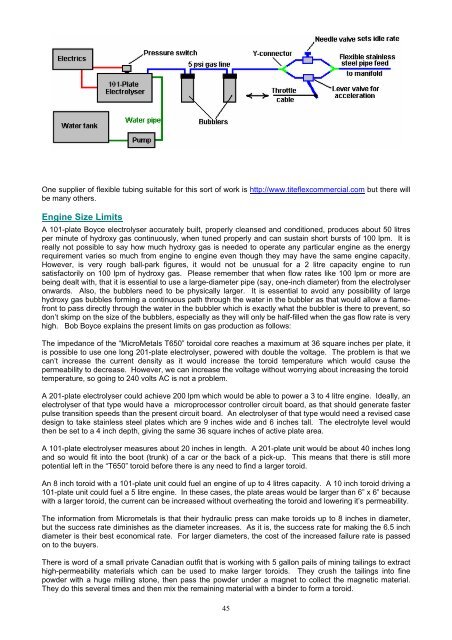Electrolyser designs - Free Energy Info
Electrolyser designs - Free Energy Info
Electrolyser designs - Free Energy Info
- No tags were found...
You also want an ePaper? Increase the reach of your titles
YUMPU automatically turns print PDFs into web optimized ePapers that Google loves.
One supplier of flexible tubing suitable for this sort of work is http://www.titeflexcommercial.com but there willbe many others.Engine Size LimitsA 101-plate Boyce electrolyser accurately built, properly cleansed and conditioned, produces about 50 litresper minute of hydroxy gas continuously, when tuned properly and can sustain short bursts of 100 lpm. It isreally not possible to say how much hydroxy gas is needed to operate any particular engine as the energyrequirement varies so much from engine to engine even though they may have the same engine capacity.However, is very rough ball-park figures, it would not be unusual for a 2 litre capacity engine to runsatisfactorily on 100 lpm of hydroxy gas. Please remember that when flow rates like 100 lpm or more arebeing dealt with, that it is essential to use a large-diameter pipe (say, one-inch diameter) from the electrolyseronwards. Also, the bubblers need to be physically larger. It is essential to avoid any possibility of largehydroxy gas bubbles forming a continuous path through the water in the bubbler as that would allow a flamefrontto pass directly through the water in the bubbler which is exactly what the bubbler is there to prevent, sodon’t skimp on the size of the bubblers, especially as they will only be half-filled when the gas flow rate is veryhigh. Bob Boyce explains the present limits on gas production as follows:The impedance of the “MicroMetals T650” toroidal core reaches a maximum at 36 square inches per plate, itis possible to use one long 201-plate electrolyser, powered with double the voltage. The problem is that wecan’t increase the current density as it would increase the toroid temperature which would cause thepermeability to decrease. However, we can increase the voltage without worrying about increasing the toroidtemperature, so going to 240 volts AC is not a problem.A 201-plate electrolyser could achieve 200 lpm which would be able to power a 3 to 4 litre engine. Ideally, anelectrolyser of that type would have a microprocessor controller circuit board, as that should generate fasterpulse transition speeds than the present circuit board. An electrolyser of that type would need a revised casedesign to take stainless steel plates which are 9 inches wide and 6 inches tall. The electrolyte level wouldthen be set to a 4 inch depth, giving the same 36 square inches of active plate area.A 101-plate electrolyser measures about 20 inches in length. A 201-plate unit would be about 40 inches longand so would fit into the boot (trunk) of a car or the back of a pick-up. This means that there is still morepotential left in the “T650” toroid before there is any need to find a larger toroid.An 8 inch toroid with a 101-plate unit could fuel an engine of up to 4 litres capacity. A 10 inch toroid driving a101-plate unit could fuel a 5 litre engine. In these cases, the plate areas would be larger than 6” x 6” becausewith a larger toroid, the current can be increased without overheating the toroid and lowering it’s permeability.The information from Micrometals is that their hydraulic press can make toroids up to 8 inches in diameter,but the success rate diminishes as the diameter increases. As it is, the success rate for making the 6.5 inchdiameter is their best economical rate. For larger diameters, the cost of the increased failure rate is passedon to the buyers.There is word of a small private Canadian outfit that is working with 5 gallon pails of mining tailings to extracthigh-permeability materials which can be used to make larger toroids. They crush the tailings into finepowder with a huge milling stone, then pass the powder under a magnet to collect the magnetic material.They do this several times and then mix the remaining material with a binder to form a toroid.45
















